Hi, I was hoping to get some assistance with translating Mei on a few of my pieces. First piece is attached here. Any help is much appreciated. Thanks.
|
|||||||||
 |
Nihonto ClubJapanese Sword Information Exchange |
User login |
|
|
Disclaimer: Nihontō Club owners and independent contributors will not be held responsible for any loss, damage or inconvenience caused as a result of any inaccuracy or error within this website. Except where otherwise noted, this page is licensed under a Creative Commons License.
|
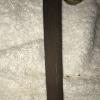
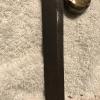


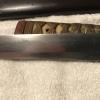
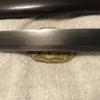

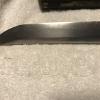
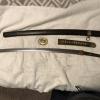
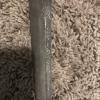
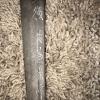

Katsumasa
Hi,
The last kanji is barely visible in your pictures, but I believe the signature is:
NOuSHUu SEKI JUu KOJIMA KATSUMASA
In the database, the smith is likely KAT75.
On your first picture, I can see a "Seki stamp" up near the top. This means it is a "GUNTOu" that was made with war-time (WWII) shortcuts. So, not a traditional Japanese sword, but rather it is "militaria".
And now a minor rant - not directed at you 'CJKenji', just venting a bit in general:
At your convenience, please confirm that you saw my reply.
I am NOT the owner of nihontoclub.com (that would be Stan), but I am often someone responding to help requests like yours.
My frustration is that way too often when I help someone on this site, I never get a response to my efforts... The latest example is user "A7x" a couple of weeks ago. Am I wasting my time? Perhaps some folks don't understand that reading/interpreting someone else's sword, and using pictures that are often poor quality, takes a non-zero amount of time and effort.
OK, venting complete - thanks for reading! :-)
Pete
Pete, Thank you so much for
Pete,
Thank you so much for the quick response and much appreciate the effort! I did get the blade from someone selling WWII memorabilia and it was in gunto mountings but I thought I would check to see. I do have a couple others I was hoping to get help with and if you are busy or not interested completely understand but if you are let me know and I can post pics of those. However some of them the kanji is a little worn down. Any tips of what I can do to make it a little clearer? From ebay and such it looks like some people rub wax or something into the mei to make it stand out from the rest of the tang but i never found out what they use.
Thanks again for the help.
CJ
pix
Hi, Thanks for your reply to my reply!
I would say you should post your other blades in any case - I'm not the only one that will look at them.
As for making the kanji easier to photograph:
- Try placing a desk lamp at various angles, to make shadows...
- You could try doing a 'rubbing' - wrap the tang with thin paper, then use the side of a pencil lead to make an 'image'.
- Try dusting the tang with talcum powder. I would use an unscented type.
Pete
Ok, added two pics of another
Ok, added two pics of another one. Let me know if it isn't clear enough and I'll try to brighten up some.
CJ
Yoshinaga
Hi,
The signature appears to be:
NOuSHUu SEKI JUu NAGA-something YOSHINAGA something.
If I'm reading it correctly, this is a not-well-documented smith. The second 'something' isn't clear enough in the pictures, but it is likely "SAKU", meaning "made by".
It's interesting that the mekugi-ana (hole in the tang) appears to have a copper plug.
This MIGHT mean that it's an older blade, and the original hole was not in a good place for the new WWII handle, so they plugged it and made a new hole. However, the tang in general doesn't look very old, so it's a bit suspicious.
If you like, post additional pictures of the blade, with ALL metal fittings removed. Such as one of the overall blade, then 3 or 4 of closer views of sections of the blade.
Pete
Ok, I'll take some more pics
Ok, I'll take some more pics and see if I can get the signature clearer. The blade is definitely a chisakatana that was cut down probably for a merchant or non-samurai.
More pics attached
Here are some of the blade. I'll see if I can get a clearer image of the signature.
Yoshinaga
Yes, the second "something" is indeed SAKU.
Still don't know what the first "something" is.
Found a minor reference. See reply #12 in this thread:
http://www.militaria.co.za/nmb/topic/7712-translation-help-kanenaga-yosh...
Why do you say it was cut down? The tang is definitely NOT shortened.
If the tip-end were shortened, it would be because it was broken. Nobody would shorten the tip-end on purpose.
If the hamon in the tip follows the shape of the tip correctly, then it was NOT reshaped (I can't see what the hamon does in the tip in your picture).
Pete
Another WWII?
Thanks Pete. So based on this you are thinking it is another WWII make? My assumption of the blade being shortened was because it looked to me like the hamon went a little further down and then cut off at the tang. Also, I checked and it definitely wraps around kissaki so that was shortened. Okay, 2 down. Thanks again.
yes, WWII
Yes, it has many features that make it look like a WWII blade, and nothing that I can see that would indicate an older blade.
>I checked and it definitely wraps around kissaki so that was shortened
I think you meant to say NOT shortened.
Pete
Yeah
Not shortened. Typing faster than thinking.
3rd try
Ok this one is the one that the mei was pretty faint so i rubbed some uchiko on it to get an outline. Once again thanks for any insight you can provide.
CJ
Kanemitsu
Hi,
For starters:
The mei is "something KANEMITSU SAKU". If you browse each of the Kanemitsu's in the database, you may be able to matching up the "something". I haven't put any effort into the "something" yet.
At a glance, it doesn't look very old either, because the tang has crisp edges, no obvious rust pitting, and the chisel marks in the mei are very crisp and clear also. But I could be wrong.
Pete
More pics of the blade
Thanks Pete. It does have a little pitting especially on the backside of the tang. Maybe when I put uchiko on it I actually covered them up a little (odd because you would think that would bring them out). Anyway, I see what you mean about the chisel marks. I added some more pics of the blade in case that helps. Although I am a little confused about how to use the database. I searched on kanemitsu in the swordsmith index and it brought up a ton of hits but nothing that would help me correlate to the 'something' before it as the hits all just showed Kanemitsu by itself (which you already identified). I'm sure I'm using it incorrectly so will see if I can get more familiar tonight.
Thanks,
CJ
database
After searching on "Kanemitsu", you would click on each of the likely candidates, and see if the example signatures use similar kanji to the "something". You could rule out the older ones, such as those before the 1600's.
Pete
something
Spent some time trying to figure out the "something", but no luck.
Also looked through many of the Kanemitsu's in the database for a hint, but no luck there either.
Note: The "signature examples" seen the database on this site, or on other people's web sites, are NOT complete/comprehensive. They just represent some documented cases. The more famous the smith is, the more complete the examples are.
Pete
First kanji
Would you think the first kanji looks like a 後 ? Also thanks for spending the time looking.
kanji
Yes, it's possible... That kanji can be read as "GO" (and probably other readings). Did you find it associated with Kanemitsu?
Echigo
Sort of. In KAN1444 it has that referenced for Echigo province but not sure the signature lines up with anything in the reference.
CJ
Not really a match, I'd say.
Not really a match, I'd say. The "GO" would need to be 2nd, not 1st...
I think there's at least a chance that it is "BIZEN".
The "sosho" ("cursive") style kanji is so hard for anyone who has not studied Japanese literature. I think most young/modern Japanese folks wouldn't be able to read it either...
Pete
non-WWII
Thanks Pete. I'll continue to look and see if i can find a match somewhere. Guessing it is relatively safe to say the blade is older than WWII though right?
Thanks,
CJ
uncertain
I'm a little uncertain about the age. It's hard to tell from photos, when there isn't anything "obvious" to point to.
One thing to check:
Look at the cutting edge, the last inch or two before it goes into the habaki. If it is visibly NOT sharpened there, then it is LIKELY a WWII blade. And compare with your other blades that are certainly WWII - one or both of them may have the "dull edge" feature I'm talking about.
I've heard two explanations for this:
1) WWII "GUNTOu" blades were made this way on purpose for some reason, related to the fact that "shortcuts" were taken.
2) Many blades, even old quality blades, are this way when new. When it is routinely polished over the years, this part of the blade ends up being sharpened also. A WWII blade has never been re-polished after manufacture, so the unsharpened edge is still there.
I think option 1) is more likely the right answer. I don't believe quality blades are ever made with a dull edge near the habaki.
See this page for good advice on this topic:
https://www.japaneseswordindex.com/realold.htm
This is Rich Stein's site. I've 'known' him (e-mail only) for about 35 years. He knows what he's talking about (more than I do!).
The tsuba and tsuka (guard and handle) are definitely WWII stuff, and nothing special. So that's a concern, because often the "old family blades" were given better mountings, but not always.
Pete
Will do
Thanks Pete. Yes, familiar with that site and glad to hear it is reputable. I did check my other blades and one indeed is dull right above the habaki and one is not (oddly enough the one that has the seki stamp is sharp but I’m guessing the seller might have sharpened it). The one above looks sharpened so I guess that is somewhat of a good sign. Either way not looking to sell any of them, eventually would like to learn to polish and restore saya/tsukamaki so figuring out age would be good so I make the fittings age appropriate. Anyway, thanks again for all the help.
CJ